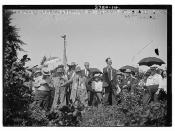Abstract
This research paper analyzes the motivation processes in place at Hewlett-Packard Corporation. Specifically, this paper examines whether Hewlett-Packard is successfully motivating its workforce through application of the four Content Theories (Hierarchy of Needs, ERG, Acquired Needs, and Two-Factor theories).
This paper concludes that there is no single content theory that can successfully stand alone as a sole motivator. The company employs all four content theory motivational strategies; a blend of these helps to consistently motivate employees to increase performance and standards.
Motivation Research Paper
Introduction
If an employee has an unsatisfied need, he or she may behave in ways that are detrimental to company growth. Organizations have toolboxes filled with options on how to deal with such behavior. Discipline or even termination is an option. However, today's workforce has taught companies that one of their most valuable resources is their human resources - their employees. Content Theories focus on the needs of employees.
"These theories suggest that the manager's job is to create a work environment that responds positively to individual needs" (Schermerhorn, Hunt, & Osborne, 2002, p.147). This paper examines whether Hewlett-Packard is successfully motivating its workforce through application of the four Content Theories (Hierarchy of Needs, ERG, Acquired Needs, and Two-Factor theories).
Hewlett-Packard and the Hierarchy of Needs Theory
The first of the four content theories is Abraham Maslow's Hierarchy of Needs. Abraham Maslow "...developed a "hierarchy of needs" or an order of needs that need to be fulfilled in each person" (Schermerhorn et al., 2002, p.XX). This theory of motivation involves five principles stages:
Physiological needs: basic needs such as food, drink, shelter, rest, etc.
Safety needs: when basic needs are reasonably satisfied, we turn to thinking about protection from danger, security, and order so that we feel safe. These can be a concern for...


